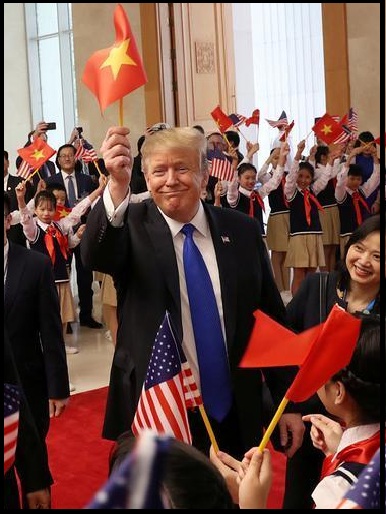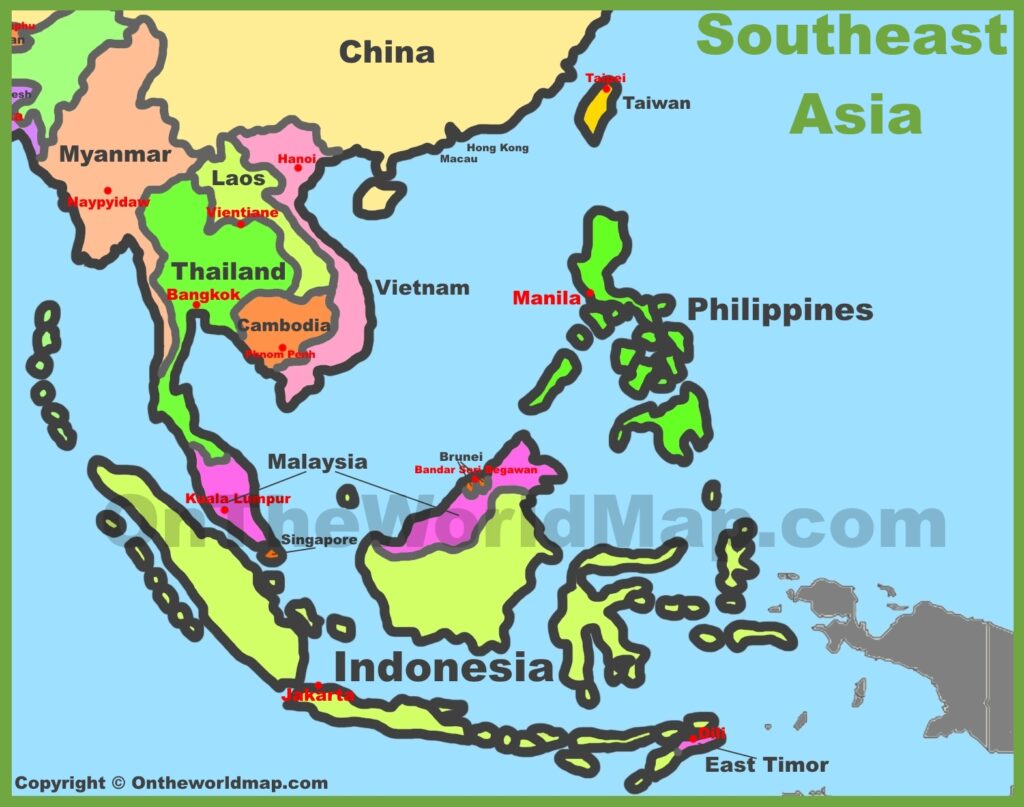


The details within the trade agreement are unique. President Donald Trump has announced a trade agreement between the USA and Vietnam. Interestingly Vietnam will face a 20% tariff rate (baseline) and a 40% tariff rate on transnational shipping.
The 40% transnational shipping rate is an interesting approach toward the process of China shipping goods to ASEAN countries to avoid direct tariffs. A transnational shipping tariff is a practical, pragmatic and honest way for the USA and Vietnam to face each other economically without masks and pretenses.
PRESIDENT TRUMP – “It is my Great Honor to announce that I have just made a Trade Deal with the Socialist Republic of Vietnam after speaking with To Lam, the Highly Respected General Secretary of the Communist Party of Vietnam. It will be a Great Deal of Cooperation between our two Countries. The Terms are that Vietnam will pay the United States a 20% Tariff on any and all goods sent into our Territory, and a 40% Tariff on any Transshipping. In return, Vietnam will do something that they have never done before, give the United States of America TOTAL ACCESS to their Markets for Trade. In other words, they will “OPEN THEIR MARKET TO THE UNITED STATES,” meaning that, we will be able to sell our product into Vietnam at ZERO Tariff. It is my opinion that the SUV or, as it is sometimes referred to, Large Engine Vehicle, which does so well in the United States, will be a wonderful addition to the various product lines within Vietnam. Dealing with General Secretary To Lam, which I did personally, was an absolute pleasure. Thank you for your attention to this matter!”
CTH was in the manufacturing base of Vietnam in January; their factories are loaded with component parts from China used to produce finished goods sent to the USA (and globally). President Trump previously told Vietnam they need to reduce their reliance on Chinese imported component goods, but China has spent billions in advanced positioning and contracts, influencing Vietnam.
Vietnam is a very poor country, and their population cannot afford to purchase the products they manufacture. They do not have a domestic consumption base. They are reliant on exports to more wealthy nations to keep their manufacturing base afloat. Practically, it is easy to have sympathy for Vietnam due to their economic dependence on both China (for imported raw materials) and the USA (for exported finished goods).
 Like Canada, Vietnam has the structural problem of an inability to comply with President Trump demands. However, unlike Canada, a wealthy nation who did this entirely to themselves as they chased leftist “green” dreams, Vietnam’s inability is an outcome of the financial windfall that came from President Trump’s first term targeting of China.
Like Canada, Vietnam has the structural problem of an inability to comply with President Trump demands. However, unlike Canada, a wealthy nation who did this entirely to themselves as they chased leftist “green” dreams, Vietnam’s inability is an outcome of the financial windfall that came from President Trump’s first term targeting of China.
During President Trump’s first term, many companies proactively moved manufacturing operations from China to other nations in Southeast Asia. Vietnam was a big benefactor of the manufacturing shift; their manufacturing base doubled in the next two years. It is smart for them to respond to the Trump tariffs by lowering their import tariff rate to zero and maintaining access to the U.S. market.
As an outcome of the 2018 tariffs against China, which coincided with a President Trump visit to southeast Asia, multiple companies shifted manufacturing operations from China to Vietnam.
Beijing saw the move and slowly increased their own strategic footprint.
In the subsequent years as COVID-19 took attention from all other matters, and with Trump removed from the equation in 2020, China increased the scale of their investment and the outcomes in 2025 are very visible.
The people who live in Vietnam do not have money; they are a very poor nation. The baseline poverty level in combination with their communist regime politics essentially eliminates their consumer power to purchase western goods and makes trade agreements between the U.S and Vietnam somewhat moot. However, as a proxy manufacturing nation Vietnam is a valuable resource for China.
Essentially what can be seen in Vietnam is how Beijing spends money there for influence. The U.S footprint is negligible in comparison to the visible influence of China. The Vietnamese market may be open, but their consumers are very poor. I doubt there will be many SUV’s heading to Vietnam.
It is a very impressive move for Vietnam and the USA to admit the dynamic of the situation; for President Trump to understand Vietnam is partly in their position due to his previous demands on the ASEAN countries; and to come to a transnational shipping tariff system that will create honesty between our two nations.
A super smart approach in a very unique situation.
♦ Semi-related. Remember when I shared the story of the factories in Vietnam and Philippines loaded with Lululemon products without labels that were transshipped from China to apparel manufacturers in southeast Asia?
EXCERPT: …In a little reported reality, in order to offset the problem, many Chinese manufacturers have actually continued the production of several branded product lines (very well-known and established brands) despite the absence of orders for the finished goods from the companies.
Several shipments of those finished goods have started to arrive at China-partnered ports. This is very interesting, because it may lead to market dumping of a higher quality product than most anticipate.
Within the apparel sector, ASEAN consumers cannot afford the fashion branded product at the prices determined by the actual brand owners. However, there is now a strong likelihood -based on what is being reported by the receivers- that the product itself will be marketed -likely dumped- without the brand label. This is actually high-quality apparel distributed for a fraction of the price of the brand.
I’ll be getting more details on this soon, however, it looks like the broad outlines are verified by multiple sources. I’ll use some fake names to explain. China is sending finished “branded” goods to the Philippines, without labeling. The receiving company awaits instructions.
Ex. “Lululemon” products arrive finished, but missing labels – the product is identical, but the IP is now stripped. The product, a summer or fall lineup, is then rebranded “Opal” apparel (fake name example) made in Philippines, packaged in a similar high-end fashion and shipped to USA where a new -mostly online- branded and marketed store sells the items. (Source)
Well, here’s the follow-up hitting the headlines today:
VIA CBS – Lululemon is suing Costco, accusing the discount retailer of selling “confusingly similar” replicas of its jackets, sweatshirts and pants.
In a lawsuit filed Friday in the U.S. District Court for the Central District of California, the athletic and lifestyle apparel company claims that certain Costco products imitate its own designs so closely that it constitutes “trade dress” infringement, which occurs when a product mimics another so closely that it confuses consumers.
The apparel company claims that Costco’s “knockoff” designs, or product “dupes,” violate trademark law because “some customers incorrectly believe these infringing products are authentic Lululemon apparel.” In other cases, “customers specifically purchase the infringing products because they are difficult to distinguish from authentic Lululemon products,” the lawsuit alleges. (MORE)
Lululemon is a Canadian company who gave China all their manufacturing business. China then makes extra product and ships it to ASEAN countries where it can be generic branded and sold at a discount. In the example above, the Lululemon product returns to the USA market under the CostCo brand. Go figure!


